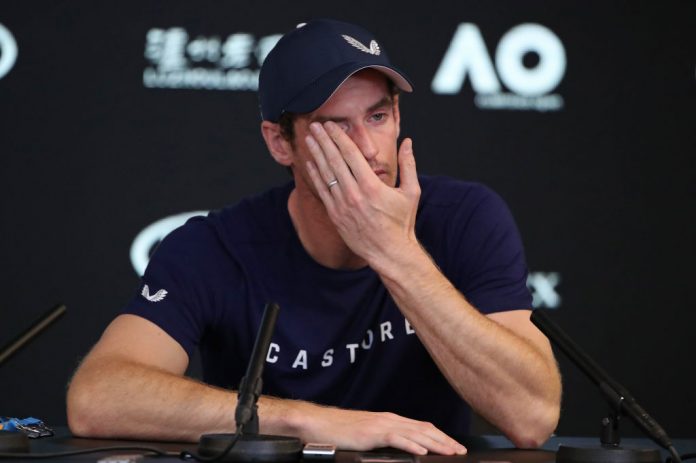
Bill Simons
We knew sad days were coming.
The great stars of our game – Federer, Serena, Venus, and others – have long been laboring in the twilights of their careers.
Still, the aging warriors battled on, struggling against time and pain. Time and again they deflected a brutal sports truth – athletes come, athletes go. “Cruel business, this handing over of the baton to the new runner,” noted writer Sue Mott.
Today, in an Australian Open press room, the dam burst, tears flowed. The pride of Scotland, 31-year-old Andy Murray, wept as he announced that the lingering pain from his right hip was too much. It was hard to watch as the proud man dipped his head and tried in vain to contain his soulful sorrow.
Once a fresh kid from the north who, in the heart of many a Brit, knocked Tiger Tim Henman off his perch, he now sat before reporters as a hobbled and humbled sportsman who could no longer practice or play the sport he loved at the level he needed to. His voice quivered. His chest heaved. His joy had vanished.
Goodness, even putting on his shoes and socks was an issue – the pain was unforgiving. He’d done everything: an operation, endless rehab sessions and assorted meetings with psychologists. He’d long been talking about the right hip problem he’d been enduring for years, that flared up after playing Stan Wawrinka at the 2017 French Open.
“I’ve talked a lot [about it]…way too much, for 18 months, with everyone,” he confided. “It’s not just the people I work with, it’s with everyone…But none of that makes my hip feel better and unfortunately I wish it did, because if it did it would be feeling brilliant just now.”
During Andy’s training block in December he came to a tough realization – he just couldn’t go on. He told his team, “I need an end point,” and added, “Wimbledon – that’s where I’d like to stop playing. [But] I’m not certain I’m able to do that. There’s a chance [the Australian Open] will be the last, because I’m not sure I’m able to play through the pain for another four, five months.”
Murray’s Melbourne press conference, which was one of the most poignant in tennis history, left us pondering many a question. Will Andy’s upcoming retirement open the floodgates to a slew of other farewells? Will he actually go on to play Wimbledon? And what a show that might be – think Lou Gehrig saying goodbye at Yankee Stadium. And what will be Andy’s place in the annals of the game?
But, aside from all these issues, there is no question about the humanity that this rather raw and clearly noble man has brought to the sport. It is no accident that he excelled in the most emotional competitions of the game – Wimbledon, the Olympics, the Davis Cup and the US Open. Reared by a single mother, Andy survived the attack of a mass murderer who descended on his Scottish school when he was in fifth grade. Later as a young teen Murray made a lonely pilgrimage to Spain to learn his craft. When he lost to Roger Federer in the 2012 Wimbledon final he made his famous “This isn’t going to be easy” speech. His tears gained hearts in countless British pubs and villages.
Yes, on court he howled. He railed against his fate. No one berated himself with the kind of unfiltered fury thaat Murray unleashed. Here was King Lear in tennis shorts. If you were in his Friends’ Box, you’d better have Andy’s back every moment. Critics sniped that his clothes were rumpled and uninspired. Few were more sullen.
But the man, often in black, played with an astonishing will, few tried harder or had more grit. He scowled, he scurried – he prevailed. Andy Murray cared. He heroically came to the aid of his cancer-ridden ATP friend, Ross Hutchins. It’s easy to see why this sensitive soul, who was once coached by Amelie Mauresmo, is the ATP’s foremost feminist. Time and again he courageously stepped up. Billie Jean King tweeted, “You are a champion on and off the court…Your greatest impact on the world may be yet to come. Your voice for equality will inspire future generations.”
And it’s no mystery why Andy performed best in the most emotional competitions we have. He predicted correctly that his first Slam victory would come at the US Open. In 2012 he won Olympic gold on Britain’s most celebrated lawn – how cool was that? In 2013 Scotland’s finest athlete became the first British man in 77 years to win Wimbledon. In 2015 Sir Andy all but single-handedly led Britain to its first Davis Cup title since 1936.
But today the 31-year-old hid behind his cap. His emotions swept him away. He’d been No. 1, had captured three majors and, you could say, even had a mountain – Wimbledon’s “Murray Mount” – named after him.
But sports mortality is a given. Soon the great Scot will retire and we no longer will be able to relish this sublime, caring man who so often delighted us as he ran to the far corners of courts, lunging to retrieve yellow balls in hopes of lifting a venerable trophy. And now we are left to muse on an unflinching truth – “Cruel business, this handing over of the baton.”


















